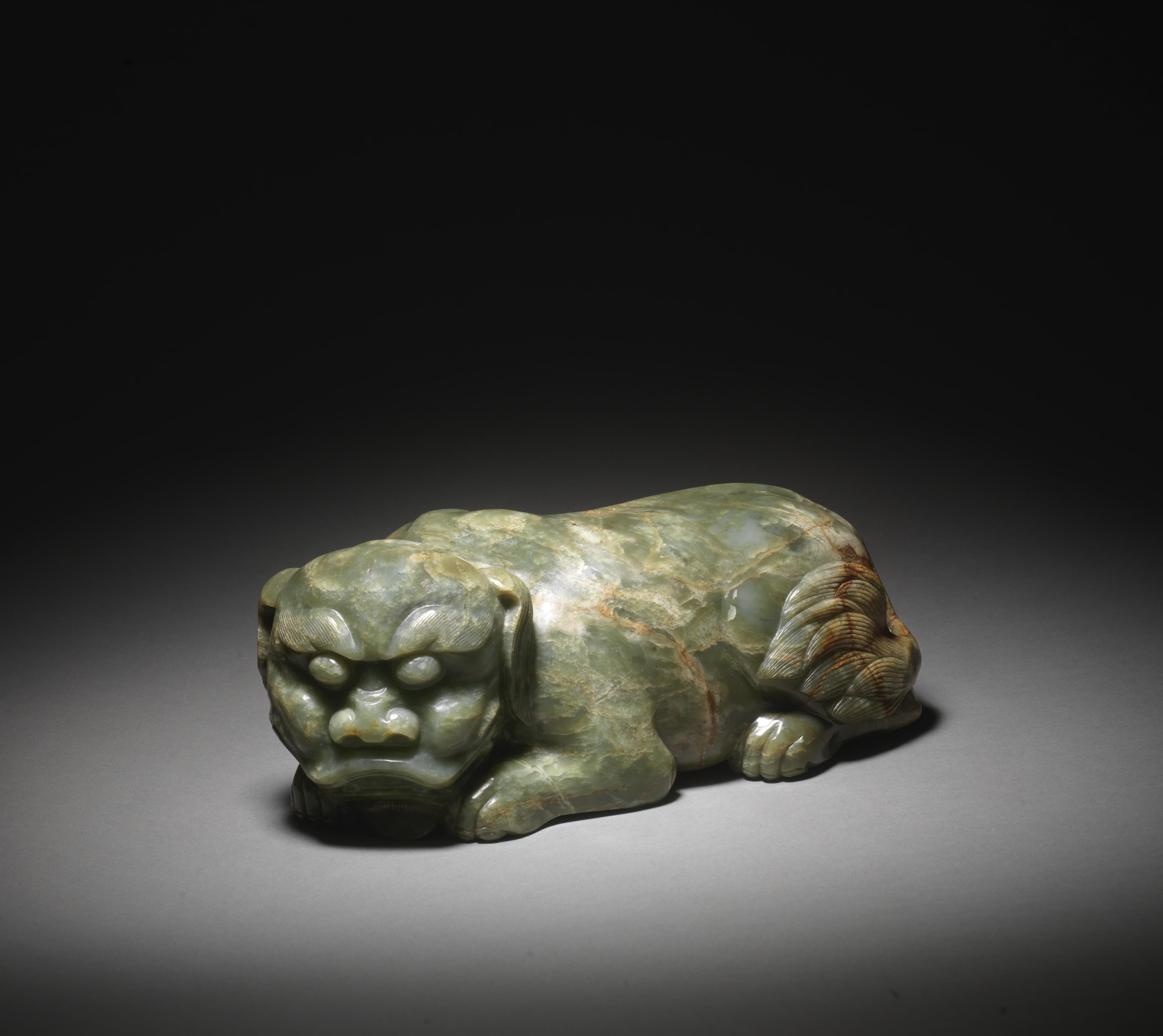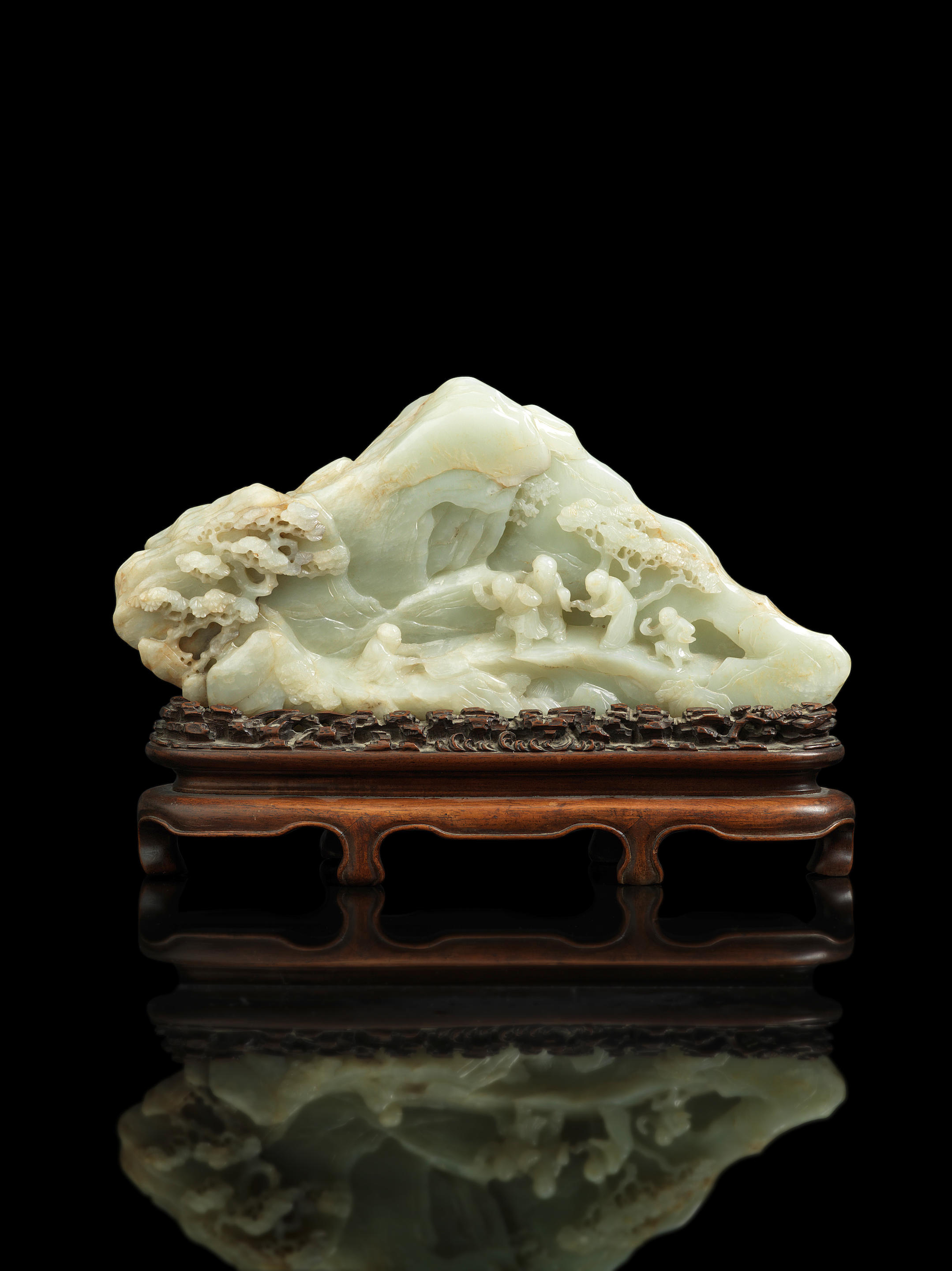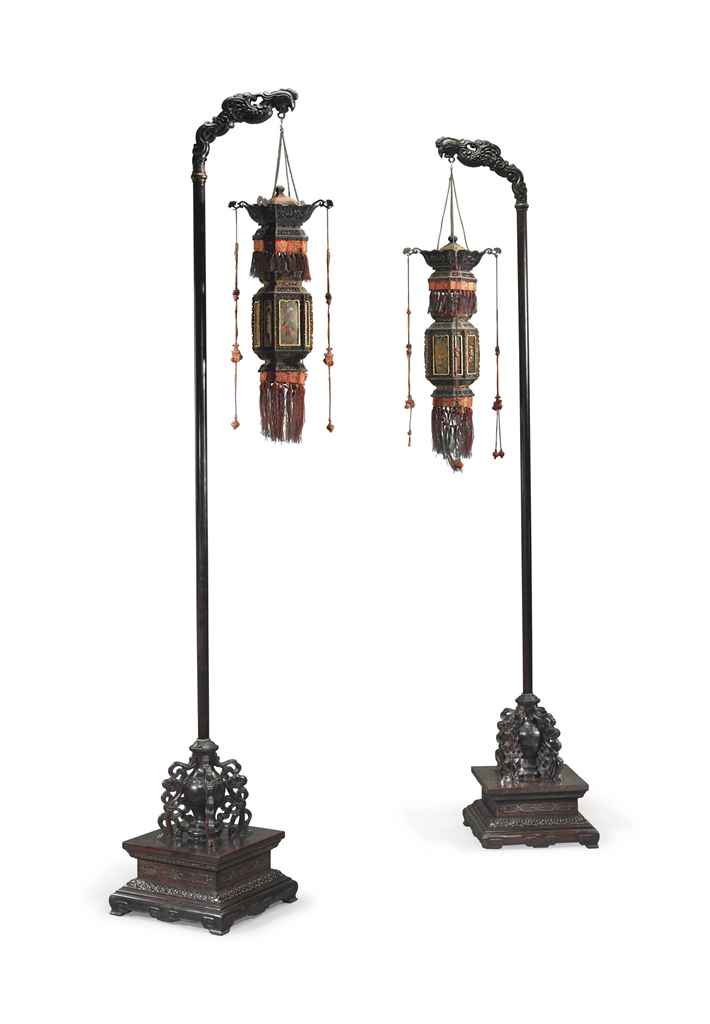PROPERTY FROM THE HAROLD AND RUTH NEWMAN COLLECTIONA MAGNIFICENT AND LARGE PALE-GREEN AND SANCAI-GLAZED CAPARISONED HORSETang dynasty The thoroughbred horse of stately proportions standing four-square on a rectangular base, the head naturalistically modeled with flared nostrils and large eyes, the mouth gently closed, one ear unusually and naturalistically flipped back as if responding to an insect, the mane docked and neatly hogged along the spine, overall covered in an attractive pale green glaze, a dark-green fur blanket thrown across the leather saddle adding accents of color to the pale green backdrop, the horse caparisoned with a leather bridle and straps over chest and crupper, decorated with suspended leaf-shaped medallions glazed in sancai colors of green, ochre and straw, which runs in attractive dripples down the body, the plinth under the feet left unglazed. 31 1/2in (80cm) high; 28in (71.4cm) longFootnotes唐 三彩綠釉大馬 Provenance: Sotheby's New York, 23 September 1997, lot 233 The Harold and Ruth Newman Collection, Connecticut, 1997-2022 出處: 紐約蘇富比,1997 年 9 月 23 日,拍品第 233 號 康州 Harold and Ruth Newman 藏,1997-2022 For a horse of similar type and size and also modeled with a dark-glazed 'fur' saddle-cloth set against a paler body tone, see Tang Chang'an chengjiao Sui Tan mu, Beijing, 1980, col. pl. 3. It was excavated in Xi'an in Shaanxi province from the tomb of Xianyu Tinghui, a high official buried in 723. The same horse is illustrated by Yutaka Mino and James Robinson Beauty and Tranquility: The Eli Lilly Collection of Chinese Art, Indianapolis Museum of Art, 1983, p. 174, fig. B. It too has a hogged mane but slightly more elaborate head harness then ours, tufts that replace the medallions on the chest of our horse, a slightly larger 'fur' blanket, and more elaborate trappings on the hind quarters. As the authors note, drawing from Edward H Schafer's, The Golden Peaches of Samarkand, Los Angeles, 1963, p. 59, "Such horses were highly prized by their owners. Aside from being conspicuously expensive and beautiful mounts, fine horses were an important basis of military power and much celebrated in Chinese history and legend. Horsemanship was considered a privilege of the ruling classes and was prohibited to artisans and tradesmen by an Imperial edict in 667. The taller, fleeter central Asian and Arabian strains were considered especially desirable and were associated with the divine steeds of ancient mythology. During the early Tang period the extension of the borders of the empire westward than at any previous time in history ensured the supply of horses for the state. It also opened the empire to extensive foreign contacts and a bustling foreign trade. The lavish style of the ornamentation of the imported horses, appears to be of foreign origin as well, probably deriving from the customs of the nomadic, hunting, and herding cultures to whom the horse was the chief means of livelihood" The 'apricot'-leaf-shaped medallions attached to the strapwork around the body, imitate the gilt-bronze horse furnishings discovered in various excavations. These elaborate trappings characteristically show the influence of Sassanian art on that of 8th century China. The complex, jewel-like decorations applied to the harness of this horse are mirrored in other Chinese decorative arts of the period. For excavated bronze examples, see Yutaka Mino and James Robinson op. cit., p. 174, pl. 61, fig E and line drawings of plaques in Wenwu, 1981, no. 10, p. 85, figs. 1-8. A feature on our horse that is seldom seen in any of the sculptural horse renderings of the Tang dynasty is the backward-flicked left ear of our model, which very naturalistically captures the moment that the horse's attention is caught by a nearby sound or the unwanted interest of an insect. It is also extremely rare to find a horse with a pale green-glazed body. More common are those with yellow, ochre and brown body glazes. Compare, for example, the slightly smaller saddled h
PROPERTY FROM THE HAROLD AND RUTH NEWMAN COLLECTIONA MAGNIFICENT AND LARGE PALE-GREEN AND SANCAI-GLAZED CAPARISONED HORSETang dynasty The thoroughbred horse of stately proportions standing four-square on a rectangular base, the head naturalistically modeled with flared nostrils and large eyes, the mouth gently closed, one ear unusually and naturalistically flipped back as if responding to an insect, the mane docked and neatly hogged along the spine, overall covered in an attractive pale green glaze, a dark-green fur blanket thrown across the leather saddle adding accents of color to the pale green backdrop, the horse caparisoned with a leather bridle and straps over chest and crupper, decorated with suspended leaf-shaped medallions glazed in sancai colors of green, ochre and straw, which runs in attractive dripples down the body, the plinth under the feet left unglazed. 31 1/2in (80cm) high; 28in (71.4cm) longFootnotes唐 三彩綠釉大馬 Provenance: Sotheby's New York, 23 September 1997, lot 233 The Harold and Ruth Newman Collection, Connecticut, 1997-2022 出處: 紐約蘇富比,1997 年 9 月 23 日,拍品第 233 號 康州 Harold and Ruth Newman 藏,1997-2022 For a horse of similar type and size and also modeled with a dark-glazed 'fur' saddle-cloth set against a paler body tone, see Tang Chang'an chengjiao Sui Tan mu, Beijing, 1980, col. pl. 3. It was excavated in Xi'an in Shaanxi province from the tomb of Xianyu Tinghui, a high official buried in 723. The same horse is illustrated by Yutaka Mino and James Robinson Beauty and Tranquility: The Eli Lilly Collection of Chinese Art, Indianapolis Museum of Art, 1983, p. 174, fig. B. It too has a hogged mane but slightly more elaborate head harness then ours, tufts that replace the medallions on the chest of our horse, a slightly larger 'fur' blanket, and more elaborate trappings on the hind quarters. As the authors note, drawing from Edward H Schafer's, The Golden Peaches of Samarkand, Los Angeles, 1963, p. 59, "Such horses were highly prized by their owners. Aside from being conspicuously expensive and beautiful mounts, fine horses were an important basis of military power and much celebrated in Chinese history and legend. Horsemanship was considered a privilege of the ruling classes and was prohibited to artisans and tradesmen by an Imperial edict in 667. The taller, fleeter central Asian and Arabian strains were considered especially desirable and were associated with the divine steeds of ancient mythology. During the early Tang period the extension of the borders of the empire westward than at any previous time in history ensured the supply of horses for the state. It also opened the empire to extensive foreign contacts and a bustling foreign trade. The lavish style of the ornamentation of the imported horses, appears to be of foreign origin as well, probably deriving from the customs of the nomadic, hunting, and herding cultures to whom the horse was the chief means of livelihood" The 'apricot'-leaf-shaped medallions attached to the strapwork around the body, imitate the gilt-bronze horse furnishings discovered in various excavations. These elaborate trappings characteristically show the influence of Sassanian art on that of 8th century China. The complex, jewel-like decorations applied to the harness of this horse are mirrored in other Chinese decorative arts of the period. For excavated bronze examples, see Yutaka Mino and James Robinson op. cit., p. 174, pl. 61, fig E and line drawings of plaques in Wenwu, 1981, no. 10, p. 85, figs. 1-8. A feature on our horse that is seldom seen in any of the sculptural horse renderings of the Tang dynasty is the backward-flicked left ear of our model, which very naturalistically captures the moment that the horse's attention is caught by a nearby sound or the unwanted interest of an insect. It is also extremely rare to find a horse with a pale green-glazed body. More common are those with yellow, ochre and brown body glazes. Compare, for example, the slightly smaller saddled h





.jpg)
.jpg)

.jpg)



Testen Sie LotSearch und seine Premium-Features 7 Tage - ohne Kosten!
Lassen Sie sich automatisch über neue Objekte in kommenden Auktionen benachrichtigen.
Suchauftrag anlegen